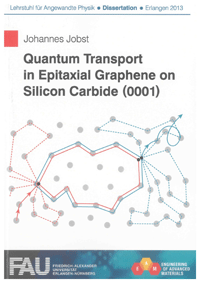
Catalogus : Recensies
Recensies

|
Johannes Jobst Quantum Transport in Epitaxial Graphene on Silicon Carbide (0001) ISBN: 978-3-8440-1707-6 Prijs: 49,80 € / 62,25 SFR |
|---|---|
|
Graphene - a two-dimensional allotrope of carbon - offers many opportunities for research in fundamental science, as well as for technological applications. First, for being a single layer of carbon atoms, which are bound in a honeycomb geometry, it represents a two-dimensional electron gas that is accessible for investigation and manipulation directly, in cantrast to conventional semiconductor-based, two-dimensional systems. Second, it is chemically and mechanically robust and offers a high electrical and thermal conductivity, while being widely transparent for visible light. And third, charge carriers in graphene mimic massless Dirac fermions as graphene exhibits a linear energy dispersion. In the present thesis, epitaxial graphene that is grown by the thermal decomposition of silicon carbide (SiC) on its (0001) basal plane is investigated. Here, monolayer graphene (MLG) with reproducible properties is formed when silicon atoms sublime at high temperatures in a well-controlled manner. In addition to MLG, a carbon-rich interface layer is formed between graphene and the SiC surface. It is electrically insulating but has a strong impact on the properties of MLG. The buffer layer can be converted to a quasi-free-standing monolayer graphene (QFMLG) by intercalation of hydrogen between buffer layer and SiC surface. This treatment reduces the coupling between QFMLG and SiC. The graphene-substrate interaction can be further reduced when free-standing epitaxial graphene (FEG) is patterned. With this method, the SiC substrate is selectively etched away with a photo-electrochemical reaction, while suspended graphene devices remain. The main topics of the present thesis are the fabrication and the electrical characterization of these three materials MLG, QFMLG and FEG. In particular, classical and quantum corrections to resistivity and conductivity, as well as the interaction with the substrate are investigated with transport and magnetotransport measurements. We observe Shubnikov-de Haas oscillations in strong fields for MLG and QFMLG samples. The sequence of maxima and minima is a strong indication that charge carriers in epitaxial graphene behave as quasi-relativistic, chiral particles. The observation of the half-integer quantum Hall effect in MLG confirms this finding. Consequently, the pseudo-relativistic physics, which is theoretically expected and is visible in exfoliated graphene, is also present in epitaxial graphene despite the graphene-substrate interaction. Furthermore, we study the weak localization (WL) correction, and present a routine which allows to extract the elastic scattering times for intravalley and intervalley scattering. The latter can be identified with the scattering of charge carriers on short-range potentials. Universal conductance fluctuations are observed in the mesoscopic FEG samples. In the presence of disorder (in the diffusive regime), electron-electron interaction (EEI) is enhanced and results in a resistivity correction that is logarithmic in temperature. Moreover, EEI causes a parabolic magnetoresistivity in intermediate fields. The curvature of these parabolas also exhibit a logarithmic temperature dependence. We show that the slope of this temperature dependence can unambiguously be identified with the EEI correction. In particular, it allows to separate the contribution of EEI from other quantum corrections that cause a logarithmic temperature dependence. We present a parameter-free description of the underlying physics. The Kondo effect - the interaction of the conduction electrons with local spin moments - also causes a logarithmic temperature dependence of the resistivity. Consequently, the contribution of the Kondo effect is difficult to identify from temperature-dependent resistivity measurements and EEI can easily be misinterpreted as Kondo effect. We discuss the similarity of the Kondo and EEI correction critically and present measurements of MLG samples that are decorated with ferrocenium ions, which carry an unpaired spin. In the latter, we observe a Kondo-like signal in the temperature-dependent resistivity whose amplitude increases with increasing ferrocenium concentration. |
|
| Bron: FIZ Karlsruhe, Leibniz-Institut für Informationsinfrastruktur. ETDE - Energy Database-production no.: DE13G4849 | |
| verder naar publicatie ... | |